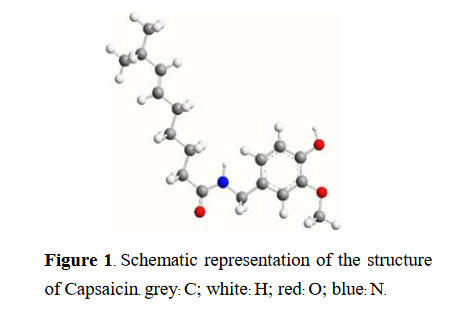Effect of Extraction Solvent on Capsaicin Content of Chinda Peppers
DOI:
https://doi.org/10.53848/ssstj.v9i2.233Keywords:
Capsaicin, Extraction, Chinda pepperAbstract
Chinda pepper (Capsicum annuum L.) is classified as a large chili pepper that is an important economic crop of Thailand. The substance in the chili pepper responsible for its spicy taste is capsaicin. Presently, capsaicin in Chinda peppers has been extracted for use in food and medical products. This research compared the capsaicin content from dried Chinda peppers in four different solvents: H2O, acetone, ethanol (95% v/v), and a binary solvent of acetone and water at a ratio of 1:1 v/v. For all treatments, the ratio of chili peppers to the solvent was 20 g:240 ml. After analyzing the amount of capsaicin content by a NanoDrop spectrophotometer, it was found that the capsaicin content from dried Chinda pepper by the H2O:acetone (1:1 v/v), acetone, H2O and ethanol (95% v/v) were 0.48 ppm, 0.26 ppm, 0.22 ppm, and 0.18 ppm, respectively. These results indicated that the extraction of capsaicin with a binary solvent of H2O:acetone at a ratio of 1:1 v/v had the highest extraction concentration. This can be explained theoretically that the presence of H2O in acetone impacted the hydrophobic properties of the solvent and the interaction between capsaicin compound and the solvent.
References
Advanced Biotech [ABT]. (2021). Oleoresins. Retrieved from https://www.adv-bio.com/oleoresins/
Attuquayefio, V. K., & Buckle, K. A. (1987). Rapid sample preparation method for HPLC analysis of capsaicinoids in capsicum fruits and oleoresins. Journal of Agricultural and Food Chemistry, 35(5), 777-779. doi:10.1021/jf00077a032
Barbero, G. F., Liazid, A., Palma, M., & Barroso, C. G. (2008). Ultrasound-assisted extraction of capsaicinoids from peppers. Talanta, 75(5), 1332-1337. doi:10.1016/j.talanta.2008.01.046
Barbero, G. F., Palma, M., & Barroso, C. G. (2006). Determination of capsaicinoids in peppers by microwave-assisted extraction-high performance liquid chromatography with fluorescence detection. Analytica Chimica Acta, 578(2), 227-233. doi:10.1016/j.aca.2006.06.074
Chinn, M. S., Sharma-Shivappa, R. R., & Cotter, J. L. (2011). Solvent extraction and quantification of capsaicinoids from Capsicum chinense. Food and Bioproducts Processing, 89(4), 340-345. doi:10.1016/j.fbp.2010.08.003
Food and Agriculture Organization of the United Nations [FAO]. (2021). Retrieved from www.fao.org
Imbarex. (2021). Paprika oleoresin: Orange natural dye. Retrieved from https://www.imbarex.com/paprika-oleoresin-orange-naturaldye/
Juangsamoot, J., Ruangviriyachai, C., Techawongstien, S., & Chanthai, S., (2012). Determination of capsaicin and dihydrocapsaicin in some hot chilli varieties by RP-HPLC-PDA after magnetic stirring extraction and clean up with C18 cartridge. International Food Research Journal, 19(3), 1217-1226. doi:10.1155/2012/380574
Kaale, E., Schepdael, A. V., Roets, E., & Hoogmartens, J. (2002). Determination of capsaicinoids in topical cream by liquid-liquid extraction and liquid chromatography. Journal of Pharmaceutical and Biomedical Analysis, 30(4), 1331-1337. doi:10.1016/s0731-7085(02)00476-4
Karnka, R., Rayanakorn, M., Watanesk, S., & Vaneesorn, Y. (2002). Optimization of highperformance liquid chromatographic parameters for the determination of capsaicinoid compounds using the simplex method. Analytical Sciences, 18(6), 661-665. doi:10.2116/analsci.18.661
Kobata, K., Kawamura, M., Toyoshima, M., Tamura, Y., Ogawa, S., & Watanabe, T. (1998). Lipase-catalyzed synthesis of capsaicin analogs by amidation of vanillylamine with fatty acid derivatives. Biotechnology Letters, 20, 451-454. doi:10.1023/A:1005567923159
Kurian, A. L., & Starks, A. N. (2002). HPLC analysis of capsaicinoids extracted from whole orange habanero chili peppers. Journal of Food Science, 67(3), 956-962. doi:10.1111/j.1365-2621.2002.tb09435.x
National Library of Medicine. (2021). Retrieved from https://pubchem.ncbi.nlm.nih.gov/compound/Capsaicin
Rostagno, M. A., Palma, M., & Barroso, C. G. (2003). Ultrasound-assisted extraction of soy isoflavones. Journal of Chromatography A, 1012(2), 119-128. doi:10.1016/s0021-9673(03)01184-1
Santamaria, R. I., Reyes-Duarte, M. D., Barzana, E., Fernando, D., Gama, F. M., Mota, M., & Lopez-Munguia, A. (2000). Selective enzymemediated extraction of capsaicinoids and carotenoids from chili guajillo puya (Capsicum annuum L.) using ethanol as solvent. Journal of Agricultural and Food Chemistry, 48(7), 3063-3067. doi:10.1021/jf991242p
Spicer, O., & Almirall, J. R. (2005). Extraction of capsaicin in aerosol defense sprays from
fabrics. Talanta, 67(2), 377-382. doi:10.1016/j.talanta.2005.05.031
Tapia, J. C., Garcia, R., Escamilla, E. M., Calva, G., & Rocha, J. A. (1993). Capsaicin recovery from a cell culture broth. Industrial & Engineering Chemistry Research, 32(10), 2242-2246. doi:10.1021/ie00022a007
Thomas, B. V., Schreiber, A. A., & Weisskopf, C. P. (1998). Simple method for quantitation of capsaicinoids in peppers using capillary gas chromatography. Journal of Agricultural and Food Chemistry, 46(7), 2655-2663. doi:10.1021/jf970695w













